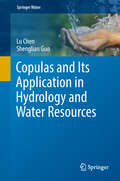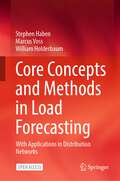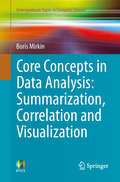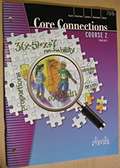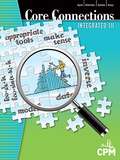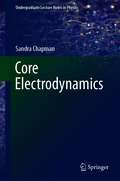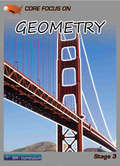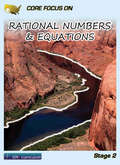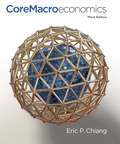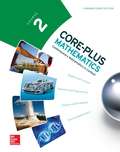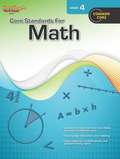- Table View
- List View
Copulas and Its Application in Hydrology and Water Resources (Springer Water)
by Lu Chen Shenglian GuoThis book presents an overview of copula theory and its application in hydrology, and provides valuable insights, useful methods and practical applications for multivariate hydrological analysis using copulas. In addition, it extends the traditional bivariate model to trivariate or multivariate models. The specific applications covered include the study of flood frequency analysis, drought frequency analysis, dependence analysis, flood coincidence risk analysis and statistical simulation using copulas. The book offers a valuable guide for researchers, scientists and engineers working in hydrology and water resources, and will also benefit graduate or doctoral students with a basic grasp of copula functions who want to learn about the latest research developments in the field.
Core Concepts and Methods in Load Forecasting: With Applications in Distribution Networks
by William Holderbaum Stephen Haben Marcus VossThis comprehensive open access book enables readers to discover the essential techniques for load forecasting in electricity networks, particularly for active distribution networks.From statistical methods to deep learning and probabilistic approaches, the book covers a wide range of techniques and includes real-world applications and a worked examples using actual electricity data (including an example implemented through shared code). Advanced topics for further research are also included, as well as a detailed appendix on where to find data and additional reading. As the smart grid and low carbon economy continue to evolve, the proper development of forecasting methods is vital. This book is a must-read for students, industry professionals, and anyone interested in forecasting for smart control applications, demand-side response, energy markets, and renewable utilization.
Core Concepts in Data Analysis: Summarization, Correlation And Visualization (Undergraduate Topics in Computer Science)
by Boris MirkinCore Concepts in Data Analysis: Summarization, Correlation and Visualization provides in-depth descriptions of those data analysis approaches that either summarize data (principal component analysis and clustering, including hierarchical and network clustering) or correlate different aspects of data (decision trees, linear rules, neuron networks, and Bayes rule). Boris Mirkin takes an unconventional approach and introduces the concept of multivariate data summarization as a counterpart to conventional machine learning prediction schemes, utilizing techniques from statistics, data analysis, data mining, machine learning, computational intelligence, and information retrieval. Innovations following from his in-depth analysis of the models underlying summarization techniques are introduced, and applied to challenging issues such as the number of clusters, mixed scale data standardization, interpretation of the solutions, as well as relations between seemingly unrelated concepts: goodness-of-fit functions for classification trees and data standardization, spectral clustering and additive clustering, correlation and visualization of contingency data. The mathematical detail is encapsulated in the so-called "formulation" parts, whereas most material is delivered through "presentation" parts that explain the methods by applying them to small real-world data sets; concise "computation" parts inform of the algorithmic and coding issues. Four layers of active learning and self-study exercises are provided: worked examples, case studies, projects and questions.
Core Connections Course 2 Version 5
by Leslie Dietiker Evra Baldinger Michael Kassarjian Barbara ShreveCore Connections Course 2
Core Connections Integrated II
by Leslie DietikerCore Connections Integrated II Core Connections Integrated II is the second course in a five-year sequence of college preparatory mathematics courses that starts with Core Connections Integrated I and continues through Calculus Third Edition. It aims to formalize and extend the geometry that students have learned in previous courses. It does this by focusing on establishing triangle congruence criteria using rigid motions and formal constructions and building a formal understanding of similarity based on dilations and proportional reasoning. It also helps students develop the concepts of formal proof, explore the properties of two- and three-dimensional objects, work within the rectangular coordinate system to verify geometric relationships and prove basic theorems about circles. Students also use the language of set theory to compute and interpret probabilities for compound events. On a daily basis, students in Core Connections Integrated II use problem-solving strategies, questioning, investigating, analyzing critically, gathering and constructing evidence, and communicating rigorous arguments justifying their thinking. Under teacher guidance, students learn in collaboration with others while sharing information, expertise, and ideas.
Core Connections Integrated III, Version 5.0
by Judy Kysh Michael Kassarjian Karen WoottonNIMAC-sourced textbook
Core Connections: Course 3, Foundations for Algebra Toolkit
by Cpm TeamCore Connections: Foundations for Algebra Toolkit contains the useful math notes from your textbook on the topics you will study.
Core Electrodynamics (Undergraduate Lecture Notes in Physics)
by Sandra ChapmanThis book is intended to engage the students in the elegance of electrodynamics and special relativity, whilst giving them the tools to begin graduate study. Here, from the basis of experiment, the authors first derive the Maxwell equations and special relativity. Introducing the mathematical framework of generalized tensors, the laws of mechanics, Lorentz force and the Maxwell equations are then cast in manifestly covariant form. This provides the basis for graduate study in field theory, high energy astrophysics, general relativity and quantum electrodynamics. As the title suggests, this book is “electrodynamics lite”. The journey through electrodynamics is kept as brief as possible, with minimal diversion into details, so that the elegance of the theory can be appreciated in a holistic way. It is written in an informal style and has few prerequisites; the derivation of the Maxwell equations and their consequences is dealt with in the first chapter. Chapter 2 is devoted to conservation equations in tensor formulation; here, Cartesian tensors are introduced. Special relativity and its consequences for electrodynamics are introduced in Chapter 3 and cast in four-vector form, and here, the authors introduce generalized tensors. Finally, in Chapter 4, Lorentz frame invariant electrodynamics is developed. Supplementary material and examples are provided by the two sets of problems. The first is revision of undergraduate electromagnetism, to expand on the material in the first chapter. The second is more advanced corresponding to the remaining chapters, and its purpose is twofold: to expand on points that are important, but not essential, to derivation of manifestly covariant electrodynamics, and to provide examples of manipulation of cartesian and generalized tensors. As these problems introduce material not covered in the text, they are accompanied by full worked solutions. The philosophy here is to facilitate learning by problem solving, as well as by studying the text. Extensive appendices for vector relations, unit conversion and so forth are given with graduate study in mind.
Core Focus on Decimals and Fractions
by Shannon MccawYour math book has features that will help you be successful in this course.
Core Focus on Geometry, Stage 3
by Beth Armstrong Shannon McCaw Matt McCaw Sarah Schuhl Michelle Terry Scott ValwayNIMAC-sourced textbook
Core Focus on Linear Equations (Stage #3)
by Beth Armstrong Shannon McCaw Matt McCaw Sarah Schuhl Michelle Terry Scott ValwayNIMAC-sourced textbook
Core Focus on Rational Numbers & Equations, Stage 2
by Beth Armstrong Shannon McCaw Matt McCaw Sarah Schuhl Michelle Terry Scott ValwayNIMAC-sourced textbook
Core Focus on Ratios, Rates & Statistics (Stage #1)
by Beth Armstrong Shannon McCaw Matt McCaw Sarah Schuhl Michelle Terry Scott ValwayNIMAC-sourced textbook
Core Focus on Ratios, Rates and Statistics
by Sharon MccawLearn more about how good math skills will help you evaluate information and make good decisions in your life.
Core Macroeconomics (3rd Edition)
by Eric P. Chiang Gerald W. StoneWith this new edition, Eric Chiang transforms CoreMacroeconomics into a text/media resource well attuned to today’s students. Long active in the economics education community, Chiang brings a contemporary teacher’s perspective to the book, supporting a variety of learning approaches by introducing modern topics, new pedagogy, a more visual presentation, and well-integrated media tools. All this while maintaining the book’s defining focus on just those topics instructors cover most often in the course.
Core Plus Mathematics, Course 2, Student Edition (Elc: Core Plus Ser.)
by McGraw-Hill Hirsch2015A mathematics textbook.
Core Standards For Math, Grade 4
by Steck-Vaughn CompanyCore Standards for Math includes 2-page lessons for every Common Core State Standard for Mathematics. Each lesson includes step-bystep instruction, modeling, and ample practice opportunities with open-response and multiple-choice items. In addition, problem solving is integrated into every lesson to help students apply skills to real-world situations.
Core Standards For Math, Grade 4 (Steck-vaughn School Supply Ser.)
by Steck-Vaughn CompanyNIMAC-sourced textbook
Core-Plus Mathematics: Contemporary Mathematics in Context, Course 1
by James T. Fey Ann E. Watkins Christian R. Hirsch Eric W. Hart Harold L. SchoenCore-Plus Mathematics, is a standards-based, four-year integrated series covering the same mathematics concepts students learn in the Algebra 1-Geometry-Algebra 2-Precalculus sequence. Concepts from algebra, geometry, probability, and statistics are integrated, and the mathematics is developed using context-centered investigations. Developed by the CORE-Plus Math Project at Western Michigan University with funding from the National Science Foundation (NSF),Core-Plus Mathematicsis written for all students to be successful in mathematics. Core-Plus Mathematicsis the number one high school NSF/reform program and it is published by Glencoe/McGraw-Hill, the nation’s number one secondary mathematics company.
Core-Plus Mathematics: Contemporary Mathematics in Context, Course 1
by James T. Fey Christian R. Hirsch Eric W. HartContemporary Mathematics in Context engages students in investigation-based, multi-day lessons organized around big ideas. Important mathematical concepts are developed in relevant contexts by students in ways that make sense to them. Courses 1, along with Courses 2 and 3, comprise a core curriculum that upgrades the mathematics experience for all your students. Course 4 is designed for all college-bound students. Developed with funding from the National Science Foundation, each course is the product of a four-year research, development, and evaluation process involving thousands of students in schools across the country.
Core-Plus Mathematics: Contemporary Mathematics in Context, Course 2
by James T. Fey Ann E. Watkins Christian R. Hirsch Eric W. Hart Harold L. SchoenCore-Plus Mathematics, is a standards-based, four-year integrated series covering the same mathematics concepts students learn in the Algebra 1-Geometry-Algebra 2-Precalculus sequence. Concepts from algebra, geometry, probability, and statistics are integrated, and the mathematics is developed using context-centered investigations. Developed by the CORE-Plus Math Project at Western Michigan University with funding from the National Science Foundation (NSF),Core-Plus Mathematicsis written for all students to be successful in mathematics. Core-Plus Mathematicsis the number one high school NSF/reform program and it is published by Glencoe/McGraw-Hill, the nation's number one secondary mathematics company.
Core-Plus Mathematics: Contemporary Mathematics in Context, Course 3
by James T. Fey Christian R. Hirsch Eric W. HartCore-Plus Mathematics, is a standards-based, four-year integrated series covering the same mathematics concepts students learn in the Algebra 1-Geometry-Algebra 2-Precalculus sequence. Concepts from algebra, geometry, probability, and statistics are integrated, and the mathematics is developed using context-centered investigations. Developed by the CORE-Plus Math Project at Western Michigan University with funding from the National Science Foundation (NSF),Core-Plus Mathematicsis written for all students to be successful in mathematics. Core-Plus Mathematicsis the number one high school NSF/reform program and it is published by Glencoe/McGraw-Hill, the nation's number one secondary mathematics company.
Corona-Kommunikation: Eine Krise in Wissenschaft, Politik und Medien
by Marc-Denis WeitzeDie Beiträge der Wissenschaft in der Corona-Krise waren vielfältig. Sie reichten von der Impfstoffentwicklung über Aerosolforschung bis hin zu Modellierungen. Es gab viele Erfolgsmeldungen. Virologen wurden zu Medienstars. Wissenschaft, Politik und Medien sprachen zeitweise mit einer Stimme – ein Siegeszug der Wissenschaftskommunikation? Es gab aber auch überzogene Versprechungen, dünnhäutige Reaktionen bei Kritik und Einseitigkeit in der Politikberatung – ein kommunikatives Desaster für Wissenschaft, Politik und Medien?Dieses Sachbuch möchte die Diskussion zur Corona-Kommunikation in Wissenschaft, Politik und Medien anregen. Es basiert auf Fallstudien, die aus verschiedenen Perspektiven beleuchtet werden, ordnet Beispiele entlang der Kriterien etablierter Wissenschaftsorganisationen ein und formuliert Fragen an die künftige Wissenschaft und ihre Kommunikation.Ist dies eine Studie, Materialsammlung oder Streitschrift? Alles. Aber hauptsächlich ein Plädoyer: Gegen unantastbare Wahrheiten, Meinungshomogenisierung und Ausgrenzung. Für Transparenz, Pluralität und Dialog in Wissenschaft und Kommunikation.
